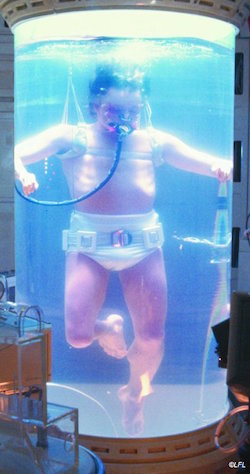Science Fiction
Dictionary
A B C D E F G H I J K L M N O P Q R S T U V W X Y Z
Bioreactor Helps Legless Frogs Get Their Jump Back

Legless frogs, they're everywhere. Now, though, a Tufts team of human scientists is trying to make it up to them with partial hindlimb regeneration. They should put it on Kickstarter (heh).
(Regeneration tech takes a leap forward)
Researchers led by Tufts University biologists and engineers have found that delivering progesterone to an amputation injury site can induce the regeneration of limbs in otherwise non-regenerative adult frogs—a discovery that furthers understanding of regeneration and could help advance treatment of amputation injuries. The researchers created a wearable bioreactor attached to the wound site to deliver the progesterone locally for a 24-hour period and observed that it had a lasting beneficial effect on tissue regrowth, allowing the frogs to partially regenerate their hind-limbs. A mere 24 hour of exposure led to 9 months of changes in gene expression, innervation, and patterned growth. The finding, published today in Cell Reports, suggests the drug-device combination could be a new model for systematically testing and deploying therapeutic cocktails that could induce regeneration in non-regenerative species...The wearable bioreactor delivering the progesterone was developed in the laboratory of David Kaplan, Ph.D, Stern Family Professor of Engineering and chair of the Department of Biomedical Engineering at Tufts’ School of Engineering and director of the Initiative for Neural Science, Disease & Engineering at Tufts. The device contains a silk protein-based hydrogel which is applied directly to the wound and is capable of delivering small molecule compounds to the site. Future experiments will explore additional factors that can enhance or improve upon the effects of progesterone.
Apparently, it really kind of works.
Science fiction authors love this idea, because their protagonists can take an incredible amount of damage, and still heal. Like Johnny Rico, in the movie version of Robert Heinlein's classic Starship Troopers:
I'd also call out the Gobathian from Clifford Simak's wonderful 1961 novel Time is the Simplest Thing.
And, now that I think about it, Star Wars technology included the bacta tank for wound healing.

(Star Wars bacta tank)
Via Tufts; thanks to Winchell Chung (@nyrath) of Atomic Rockets, the hard sf writer's tech support.
Scroll down for more stories in the same category. (Story submitted 11/3/2018)
Follow this kind of news @Technovelgy.| Email | RSS | Blog It | Stumble | del.icio.us | Digg | Reddit |
Would
you like to contribute a story tip?
It's easy:
Get the URL of the story, and the related sf author, and add
it here.
Comment/Join discussion ( 0 )
Related News Stories - (" Medical ")
BrainBridge Concept Transplant Of Human Head Proposed
'Briquet’s head seemed to think that to find and attach a new body to her head was as easy as to fit and sew a new dress.' - Alexander Belaev (1925)
Natural Gait With Prosthetic Connected To Nervous System
'The leg was to function, in a way, as a servo-mechanism operated by Larry’s brain...' - Charles Recour, 1949.
Brain Implant Is Able To Capture Your Inner Dialogue
'So you see, you can hide nothing from me.'
'Pregnancy Humanoids' From China Replace Moms
'A great many of these synthetic babies were made...' - David H. Keller, 1928.
Technovelgy (that's tech-novel-gee!) is devoted to the creative science inventions and ideas of sf authors. Look for the Invention Category that interests you, the Glossary, the Invention Timeline, or see what's New.
Science Fiction
Timeline
1600-1899
1900-1939
1940's 1950's
1960's 1970's
1980's 1990's
2000's 2010's
Current News
The Zapata Air Scooter Would Be Great In A Science Fiction Story
'Betty's slapdash style.'
Thermostabilized Wet Meat Product (NASA Prototype)
There are no orbiting Michelin stars. Yet.
Could Crystal Batteries Generate Power For Centuries?
'Power could be compressed thus into an inch-square cube of what looked like blue-white ice'
India Ponders Always-On Smartphone Location Tracking
'It is necessary... for your own protection.'
Amazon Will Send You Heinlein's Knockdown Cabin
'It's so light that you can set it up in five minutes by yourself...'
Is It Time To Forbid Human Driving?
'Heavy penalties... were to be applied to any one found driving manually-controlled machines.'
Replace The Smartphone With A Connected Edge Node For AI Inference
'Buy a Little Dingbat... electropen, wrist watch, pocketphone, pocket radio, billfold ... all in one.'
Artificial Skin For Robots Is Coming Right Along
'... an elastic, tinted material that had all the feel and appearance of human flesh and epidermis.'
Robot Guard Dog On Duty
I might also be thinking of K-9 from Doctor Who.
Wearable Artificial Fabric Muscles
'It is remarkable that the long leverages of their machines are in most cases actuated by a sort of sham musculature...'
BrainBridge Concept Transplant Of Human Head Proposed
'Briquet’s head seemed to think that to find and attach a new body to her head was as easy as to fit and sew a new dress.'
Google's Nano Banana Pro Presents Handwritten Math Solutions
'...copy was turned out in a charming and entirely feminine handwriting.'
Edible Meat-Like Fungus Like Barbara Hambly's Slunch?
'It was almost unheard of for slunch to spread that fast...'
Sunday Robotics 'Memo' Bot Has Unique Training Glove
'He then started hand movements of definite pattern...'
Woman Marries Computer, Vonnegut's Dream Comes True
'Men are made of protoplasm... Lasts forever.'
Natural Gait With Prosthetic Connected To Nervous System
'The leg was to function, in a way, as a servo-mechanism operated by Larry’s brain...'
